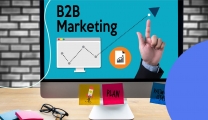Why do you need cold email marketing?
Cold email marketing can be a powerful tool for businesses looking to expand their customer base. Here are some reasons why you may want to consider incorporating cold email into your marketing strategy:
- Reach a new audience: Cold email allows you to reach people who may not have heard of your business or product before. This can be particularly valuable if you're targeting a new market or looking to expand your customer base.
- Generate leads: By reaching out to potential customers directly, you can generate new leads for your business. Cold email can be an effective way to build your email list and connect with potential customers who may be interested in your product or service.
- Build brand awareness: Even if recipients don't become customers right away, cold email can help build brand awareness and establish your business as a thought leader in your industry.
- Cost-effective: Compared to other forms of marketing, cold email can be relatively low cost. With the right strategy, you can reach a large audience without spending a lot of money on advertising or other marketing efforts.

How to create a cold email campaign?
Creating a successful cold email campaign requires careful planning and execution. Here are some steps to follow when creating your campaign:
- Define your target audience: Before you start writing emails, you need to know who you're targeting. Define your ideal customer and research their pain points, needs, and interests.
- Build your email list: You'll need a list of email addresses to send your emails to. You can build your list through networking, lead magnets, and other strategies.
- Choose the best email marketing platforms: There are many email marketing automation software available, each with its own features and benefits. Consider factors like pricing, ease of use, and automation capabilities when choosing a platform.
- Craft your email: Your email should be clear, concise, and tailored to your target audience. Use a catchy subject line to grab attention, and focus on providing value in your email body.
- Personalize your emails: Personalization can increase the effectiveness of your cold email campaign. Use recipient's names, mention a common interest, or reference a recent event to make your email more personal.
- Follow up: It's unlikely that everyone on your email list will respond to your first email. Plan to follow up with non-responders to increase your chances of getting a response.

How to create a cold email campaign?
Tips for a successful cold email campaign
Now that we've covered the steps to create a cold email campaign, let's dive into some tips to ensure its success:
- Keep it short and sweet: Your email should be easy to read and get to the point quickly. Avoid lengthy paragraphs and stick to the essentials.
- Provide value: Your email should provide something of value to the recipient, whether that's information, a discount, or something else. Make sure your email is focused on the recipient, not your business.
- Use social proof: Including social proof, like customer testimonials or industry awards, can help establish credibility and build trust with the recipient.
- Use a strong CTA: Your call-to-action (CTA) should be clear and compelling. Use action-oriented language and make it easy for the recipient to take the desired action.
- Test and iterate: Don't be afraid to test different subject lines, email formats, and CTAs to see what works best. Use analytics to track your results and make adjustments as needed.

Mistakes to avoid in cold email
While cold email can be an effective strategy for reaching new customers, there are also some common mistakes to avoid. Here are some mistakes to watch out for:
- Sending unsolicited emails: Make sure you're only sending emails to people who have given you permission to do so. Sending unsolicited emails can damage your reputation and lead to spam complaints.
- Focusing too much on your business: Your email should be focused on the recipient, not your business. Avoid talking too much about yourself or your business and instead focus on providing value to the recipient.
- Using a generic approach: Your email should be tailored to the recipient and their specific needs and interests. Avoid using a one-size-fits-all approach and instead take the time to personalize your emails.
- Neglecting follow-up: Following up with non-responders is an important part of cold email. Make sure you have a plan in place to follow up with recipients who don't respond to your initial email.
- Ignoring analytics: Analytics can provide valuable insights into the effectiveness of your email campaign. Make sure you're tracking your results and making adjustments as needed.
Cold email marketing can be an effective way to reach a new audience, generate leads, and build brand awareness. By following a strategic approach and avoiding common mistakes, you can create a successful cold email campaign that connects with potential customers and drives business growth. Remember to define your target audience, build a quality email list, choose a marketing software, personalize your emails, and follow up with non-responders. Provide value, use social proof, and test and iterate to improve your results. Avoid sending unsolicited emails, focusing too much on your business, using a generic approach, neglecting follow-up, and ignoring analytics.












Replies to This Discussion